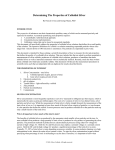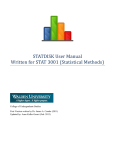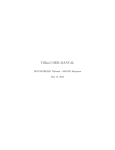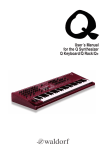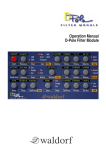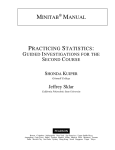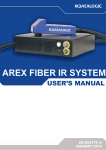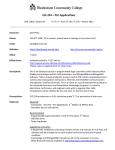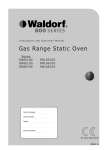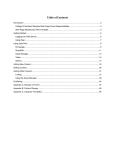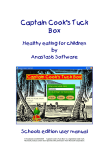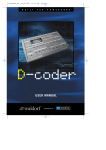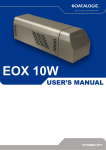Download Only a random sample of the homework and MINITAB problems will
Transcript
Math 2300-78953 – Introduction to Statistics (3 credit hours) Syllabus – Spring 2010 Instructor: Natalie Cullen http://www.itc.csmd.edu/mth/ncullen/ Email: [email protected] This is the best way to reach me I won’t open an email if I don’t know who it is from. Thus, when emailing me, the subject line of the email must be: MTH2300 followed by your first & last name. For example: “MTH2300 John Doe” Any email without this information will be deleted without being opened. Instructor Policies: 1. Only work done in lead pencil (no liquid graphite “pencils”) will be accepted. 2. All multiple page assignments must be stapled together to be accepted. 3. Only punctual assignments will be accepted. 4. Pagers and cellular phones must be turned OFF upon entering class. Text messaging during class is not permitted under any circumstances. 5. Only properly referenced emails will be opened (see above) Office Address & Phone: Waldorf Center for Higher Education Attn: Natalie Cullen 3261 Old Washington Road, Suite 1020 Waldorf, MD 20602 301-632-2929 For official emergency closing information call 1-800-650-4023 Office Hours & Location: Waldorf Center for Higher Education MW 12:00-12:30pm TTh 11:30am-1:00pm Class Times: TTH 1-2:20pm Prerequisites Mth 1080, MTH1100, or Appropriate Placement Test Score Required Materials: LaPlata Campus – ST194 MW 2:00-2:30pm LEAD PENCILS (no liquid graphite “pencils”) & ERASERS Essentials of Statistics, 3rd edition, Mario F. Triola Minitab Software and User Manual TI 83 or TI 83 Plus or TI84 (Students using other types of calculators are responsible for learning their use from the owner’s manual.) COURSE DESCRIPTION In this introductory (non-calculus) course, students learn about data presentation and analysis, measures of central tendency and dispersion, probability rules, sampling distributions, confidence intervals, correlation and regression, and hypothesis testing using the z, t and chi-square test statistics. Examples are selected from business, education, and the social and natural sciences. TIME REQUIREMENT AND EXPECTATIONS In all college math courses students should expect to spend roughly 6 to 9 hours per week outside class on reading, study, and problem solving. Since most of the learning takes place outside class, this block of study time is an essential part of the course. There is NO SUBSTITUTE for adequate study time before and after every class. It is essential that you come to EVERY class and be ON TIME. Each day we will introduce at least one new topic that will appear on an exam. It is very, very difficult to catch up if you fall behind. It is essential that you read the textbook and work the study problems. Pay careful attention to the worked out example problems in the text. Those problems are important, and they are worth careful study. It is essential that you work on statistics every day. The course moves fast, and the material is new and difficult. To learn mathematics requires practice, patience, and repetition. Good time management and study skills are essential. There are no shortcuts. But it does help to find a study partner. GRADES Your course grade will be based on the number of points that you earn out of a possible 550. There will be: 4 Unit Exams 100 points each (400 points total) 5 Homework Assignments approx. 20 points each (100 points total) 4 MINITAB Assignments approx. 12.5 pts each ( 50 points total) Only a random sample of the homework and MINITAB problems will be graded, not the whole assignment. Course grades will be assigned as follows: Letter Points Earned A 495 – 550 B 440 – 494 C 385 – 439 D 330 – 384 F 0 – 329 Percentage 90 80 70 60 less than 60 EXAMS Exams will be given only in class: Exam 1 (Chap. 1, 2, 3, 4) Exam 2 (Chap. 5 & 6) Exam 3 (Chap. 7 & 8) Exam 4 (Chap. 10 and 11) Exams are based on lectures, textbook, and homework assignments, and must be completed in lead pencil (no liquid graphite “pencils”) and are scheduled in advance. You may bring one 3x5 inch index card (both sides) of your own handwritten notes to use during the exams. You may not use photocopied or commercially printed material or any notes prepared by another person. Statistical tables will be provided for your use during exams. Make up exams are rarely given and then only under extreme circumstances (your hospitalization, death in the immediate family) and only with sufficient documentation like a doctor’s note. Notice that car trouble is not considered an extreme circumstance. You can take a cab or, if in Charles County, VanGO. No make-up exams will be administered without documentation and prior notice. If you do not get in contact with me on the day of the test, you will not be allowed to make up the test at all. In the event that you miss an exam, I will be expecting an email/phone call from you and, thus, will respond quite promptly. If you have not heard back from me shortly, keep trying until you do. It is your responsibility to get a hold of me and set up the appointment. Active communication with me is imperative. Upon my approval, you will have until I return the graded tests to the class (usually the next class period) or one calendar week to make up the test, whichever comes first. Students taking a make up test forfeit the use of any note card that may have been allowed. HOMEWORK & MINITAB ASSIGNMENTS Five homework problem sets and four assignments requiring MINITAB Statistical Software will be collected, and must be completed in lead pencil (no liquid graphite “pencils”). Only some randomly chosen problems from each assignment will be graded. Due dates are given on the attached daily schedule. Students may consult with each other during completion of these assignments, but everyone must submit his/her own paper. Photocopies and group submissions will not be accepted. Think of the problem sets as “practice exams”. It is worth your time to learn how to solve these kinds of problems. You may do the MINITAB assignments in the “open” computer labs on the CSM campuses, or on your own home computer using the software that came with the textbook. LATE ASSIGNMENTS WILL NOT BE ACCEPTED UNDER ANY CIRCUMSTANCES. Even if you miss class your assignment must be submitted on time. A list of study problems is referenced on the attached daily schedule. These problems will help you to understand the main points of the chapter, and you are strongly urged to work all of them. Since the answers to all odd numbered problems are given in the back of the book, these problems will not be collected or graded. If you don’t have time to do the homework, you don’t have time to PASS this class. DISABILITIES AND SPECIAL NEEDS Students with disabilities or special needs must contact the Learning Assistance Center to formulate an Accommodation Plan. This important legal document describes what is medically necessary in order for you to take this course. Until you present your Accommodations plan, I cannot and will not honor your requests for exams in the Testing Center, extra time, special seating, large print, a tape recorder, etc. If you believe you should have special accommodations and do not have an Accommodation Letter please contact the Disabilities Coordinator: Glennis Daniels-Bacchus Office: LaPlata Campus in LR 123 Voice: (301) 934-2251, ext. 7614 TDD: (301) 934-1188 Email: [email protected] AUDIT & WITHDRAWAL The last day to change your class status to withdraw or audit is Monday, March 29, 2010. Audits are not automatic. If you have not been completing assignments or have not had good attendance (late or absent or leaving class early more than twice), you will not be granted an audit. You will need to choose between receiving the grade you earn and withdrawing from the class entirely. The terms of the audit will be to 1. Attend, on time and without leaving early, all remaining classes, 2. Complete on time, all remaining assignments with at least the minimum amount of effort you have shown so far. Failure to comply with these terms will result in a WD for the course. It is your responsibility to initiate the paperwork in time to get the necessary signatures.. HONESTY The one time when students are not allowed to work together or to consult with each other is during exams. Any student caught cheating, or is guilty of any other form of academic dishonesty, will be dealt with by following the established policy published in the Student Handbook. As a minimum penalty it is my practice to recommend a grade of zero on the entire document involved. For serious cases, I do not hesitate to seek more severe penalties. Some of the behaviors that will be considered cheating are: Communicating with another person during an assessment Copying material from another person from any assignment being graded Allowing another person to copy from any assignment being graded Use of unauthorized assistance on any assignment being graded Use of unauthorized notes or books during an assessment Providing or receiving a copy of a quiz or exam used in the course Use of a cell phone or pager during an assessment In addition, any evidence of cheating will be forwarded to the Director of Student Affairs and the College Judicial Committee for review and possible disciplinary sanctions. UNAUTHORIZED PERSONS Unauthorized persons (children, friends, family members, and people who are not registered for this course) are not allowed in the classroom. Details of this college policy can be found in the Student Handbook. CSM MATH TEAM The CSM Math Team meets once per semester and competes with other regional colleges by taking tests and comparing results. If you choose to participate, you will receive an “extra credit” bonus of five points, plus half of the total points earned on the competitive exam, to add to one of your exam scores. To sign up, contact the La Plata Math Team coordinator, Donna Sperry, at her E-mail address, [email protected]. GENERAL EDUCATION OBJECTIVES MTH 2300 has been designated a "General Education" course. objectives for mathematics courses are found in the college catalog. OBJECTIVES OF THE COURSE The general education After completing this course, you should be able to present and analyze statistical data using: Descriptive Statistics: You should know: how to interpret the 5-number summary how to construct data tables and histograms how to find the mean, median, mode and standard deviation of ungrouped data how to find the mean and standard deviation of grouped data how to compute standardized Z scores Probability: You should know: how to compute probabilities for single, compound, and complementary events how to set up probability distributions and find the mean and standard deviation of the distribution when to use the binomial distribution and how to calculate binomial probabilities Normal Distribution: You should know: how to compute Z-scores and how to use the normal distribution table the implications of the Central Limit Theorem how to compute confidence intervals for means and proportions when and how to use the z and t statistics in a confidence interval how to determine sample size for means and proportions Hypothesis Testing: You should know: how to test the three types of claims about means and proportions of large and mall samples how to set up the null and alternative hypotheses when to use one or two tailed tests how to find and interpret p-values Regression and Goodness of Fit: You should know: how to find the equation of the least squares regression line from raw data how to find the correlation coefficient and test for significance how to find and interpret the coefficient of determination how to set up contingency tables and test for goodness of fit MATH 2300 - INTRODUCTION TO STATISTICS DAILY SCHEDULE & PROBLEM LIST SPRING 2010 Date Sections Problems January 19 READ Sections 1.1 through 1.4 lightly for an overview of statistics. READ Sections 2.1 through 2.4 thoroughly before next class. Enter the “Airliner Ages” and “Part Time Workers” data sets into your calculator before next class. Bring your calculator to class. 2.1 Overview 2.2 Frequency Distributions Page 48: 3, 5, 9, 1, 3, 15(*), 22 2.3 Histograms Page 53: 1, 3, 5, 6, 7, 8, 13 2.4 Statistical Graphics 21 READ Sections 3.1 through 3.3 in the text before class. Bring your calculator to class. 3.1 Overview 3.2 Measures of Center Page 86: 9, 11, 17 3.3 Measures of Variation Page 104: 3, 9, 11, 17, 25, 27, 33 Homework 1 will be posted to my faculty website. The MiniTAB Tutorial will be posted to my faculty website. 26 READ Section 3.4 and 3.5 in the text before class. 3.4 Measures of Relative Standing 3.5 Exploratory Data Analysis 28 READ Sections 4.1 through 4.3 and Section 4.5 in the text before class. 4.1 Overview 4.2 Probability Fundamentals Page 146: 7, 11, 13, 19, 21 4.3 Addition Rule Page 156: 7 – 20 4.5 Conditional Probability Page 173: 21 - 24 February 2 MINITAB Lab. We will meet in 3030B today. Bring a storage device and MiniTAB tutorial to class. If the college is closed, you will be responsible for working through the tutorial on your own. MINITAB Assignment 1 will be posted to my faculty website. 4 READ Sections 4.4 and 4.5 in the text before class. 4.4 Multiplication Rule Page 165: 9, 11, 15, 17 – 20 4.5 Complements Page 171: 1 – 7 odd, 11, 17, 19 9 Problem solving day. No new material. This is a day for you to ask questions. MINITAB Assignment 1 is due at the beginning of class today. Homework 1 is due at the beginning of class today. As always, late assignments will NOT be accepted. 11 EXAM 1 -- Chapters 1, 2, 3, and 4. Page 116: 1 – 13 odd Page 126: 1, 3, 5, 14 Page 131: Review Exercises 1 - 8 Date Sections Problems February 16 READ Sections 5.1 and 5.2 in the text before class. 5.1 Overview 5.2 Random Variables Page 204: 7, 9, 11, 13, 23 18 READ Section 4.3 in the text before class. 5.3 Binomial Probability Distributions Page 214: 1 – 35 odd Homework 2 will be posted to my faculty website.. 23 READ Sections 5.4, 6.1, and 6.2 in the text before class. 5.4 Binomial Mean & Variance Page 221: 1 - 19odd 6.1 Overview 6.2 Uniform and Standard Normal Page 245: 1 – 27odd, 37, 39 25 READ Sections 6.2 and 6.3 AT LEAST TWICE before class. Everything we do for the rest of the course will depend on the normal distribution. Be sure to attend today’s class. These topics are very important. 6.2 Standard Normal Distribution 6.3 Applications of the Normal Distribution Page 254: 5 – 23 odd Homework 2 is due at the beginning of class today. As always, late assignments will NOT be accepted. Homework 3 and MINITAB Assignment 2 will be posted to my faculty website. March 2 READ Section 6.4 & 6.5 in the text before class. 6.4 Sampling Distributions and Estimators 6.5 Central Limit Theorem 4 Problem solving day. No new material. This is a day for you to ask questions. Page 266: 7, 9, 11 Page 275: 1 – 19 odd Homework 3 is due at the beginning of class today. As always, late assignments will NOT be accepted. 9 EXAM 2 -- Chapters 5 & 6 Date Sections Problems March 11 READ Sections 7.1 and 7.3 in the text before class. 7.1 Overview 7.3 Estimating a Population Mean when p326: 9–29odd, 33–37odd the population variance is known 23 READ Section 7.4 in the text before class. 7.4 Estimating a Population Mean when the population variance is unknown Page 339: 5 – 27 odd MINITAB Assignment 2 is due at the beginning of class today. As always, late assignments will NOT be accepted. Homework 4 will be posted to my faculty website.. 25 READ Section 7.2 in the text before class. 7.2 Estimating a Population Proportion p 312: 5–27odd, 37–43odd MINITAB Assignment 3 will be posted to my faculty website. 30 April 1 READ Sections 8.1 and 8.2 in the text before class. 8.1 Overview 8.2 Basics of Hypothesis Testing (Ignore “Power of a Test”.) READ Section 8.4 in the text before class. 8.4 Testing a Claim about a Mean when the population variance is known p383: 9–23odd, 29–39odd Page 403: 5 – 17 odd MINITAB Assignment 3 is due at the beginning of class today. As always, late assignments will NOT be accepted. MINITAB Assignment 4 will be posted to my faculty website. 6 READ Section 8.5 in the text before class. 8.5 Testing a Claim about a Mean when the population variance is unknown 8 Problem solving day. No new material. This is a day for you to ask questions. Homework 4 is due at the beginning of class today. As always, late assignments will not be accepted.. 13 EXAM 3 -- Chapters 7 & 8 Page 411: 1 – 15 odd, 17, 19, 25, 27 Meeting April 15 Sections Problems READ Sections 10.1 through 10.4 in the text before class. 10.1 Overview 10.2 Correlation Page 500: 13, 17, 23, 25 10.3 Linear Regression Page 521: 13, 17, 23, 25 MINITAB Assignment 4 is due at the beginning of class today. As always, late assignments will not be accepted 20 RE-READ Sections 10.1 through 10.4 in the text before class. Finish Linear Regression and Correlation Homework 5 will be posted to my faculty website. 22 READ Sections 11.1 and 11.2 in the text before class. 11.1 Overview 11.2 Multinomial Experiments: Page 562: 1-4, 7, 9, 11 Goodness of Fit 27 READ Section 11.3 in the text before class. 11.3 Contingency Tables: Independence 29 Problem solving day. No new material. This is a day for you to ask questions. Exam 4 is next class. Page 578: 7, 9, 19 Homework 5 is due at the beginning of class today. As always, late assignments will not be accepted. May 4 Exam 4 -- Chapters 10 & 11 CHAPTER 2 DATA SETS Bring your calculator to class every day. Next class we will learn how to summarize data with frequency tables and histograms. Enter these data sets into your calculator BEFORE CLASS. There will NOT be time to enter the data during class. HOW TO ENTER DATA INTO THE TI-83, TI-83 Plus, or TI-84 CALCULATOR: 1. Use the STAT key and choose the EDIT option. 2. Clear the lists L2 and L3. Use the right arrow key to place the cursor on the list name L2. Press CLEAR and then ENTER to clear L2. Move the cursor to the list name L3. Press CLEAR ENTER to clear L3. 3. Type the data into L2 and L3. 4. VERY IMPORTANT STEP. Check L2 and L3 for typing errors. Correct your mistakes. If the data contains errors the results and all your conclusions will be TOTALLY WRONG. __________________________________________________________________________________ AIRLINER AGE DATA SET Lately the age of commercial airliners is causing some safety and economic concerns. We surveyed 30 randomly chosen commercial aircraft in the United States and found the following ages (in years): 3.2 22.6 23.1 16.9 0.4 6.6 22.8 0.2 7.8 8.1 13.6 7.0 21.3 15.2 11.5 2.5 4.9 5.3 5.8 10.6 3.1 9.7 12.4 27.3 22.5 3.9 4.5 16.2 24.1 2.1 Enter these airliner ages into list L2 in your calculator. __________________________________________________________________________________ PART TIME WORKER DATA SET We asked a group of 40 randomly chosen part time workers, "How many hours did you work last week?” The results, rounded to the nearest hour, are given below. 28 23 27 17 27 22 29 24 25 20 26 30 23 25 21 26 31 24 27 20 28 22 23 28 28 23 26 29 24 26 30 25 25 27 24 25 26 23 34 28 Enter these values into list L3 in your calculator.












